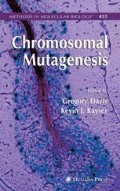Abstract
Efficient linking of primary DNA sequence information to gene functions in vertebrate models requires that genetic modifications and their effects are analyzed in an efficacious, controlled, and scalable manner. Thus, to facilitate analysis of gene function, new genetic tools and strategies are currently under development. Transposable elements, by virtue of their inherent ability to insert into DNA, can be developed into useful tools for chromosomal manipulations. Mutagenesis screens based on transposable elements have numerous advantages as they can be applied in vivo and are therefore phenotype-driven, and molecular analysis of the mutations is straightforward. Current progress in this field indicates that transposable elements will serve as indispensable tools in the genetic toolkit of vertebrate models. Here, we provide experimental protocols for the construction, functional testing, and application of the Sleeping Beauty transposon for insertional mutagenesis of the mouse germline.
Access this chapter
Tax calculation will be finalised at checkout
Purchases are for personal use only
References
Ivics, Z., Hackett, P. B., Plasterk, R. H., and Izsvak, Z. (1997) Molecular reconstruction of Sleeping Beauty, a Tc1-like transposon from fish, and its transposition in human cells. Cell 91, 501–510.
Izsvak, Z., Ivics, Z., and Plasterk, R. H. (2000) Sleeping Beauty, a wide host-range transposon vector for genetic transformation in vertebrates. J. Mol. Biol. 302, 93–102.
Luo, G., Ivics, Z., Izsvak, Z., and Bradley, A. (1998) Chromosomal transposition of a Tc1/mariner-like element in mouse embryonic stem cells. Proc. Natl. Acad. Sci. USA 95, 10,769–10,773.
Yant, S. R., Meuse, L., Chiu, W., Ivics, Z., Izsvak, Z., and Kay, M. A. (2000) Somatic integration and long-term transgene expression in normal and haemophilic mice using a DNA transposon system. Nat. Genet. 25, 35–41.
Fischer, S. E., Wienholds, E., and Plasterk, R. H. (2001) Regulated transposition of a fish transposon in the mouse germ line. Proc. Natl. Acad. Sci. USA 98, 6759–6764.
Dupuy, A. J., Fritz, S., and Largaespada, D. A. (2001) Transposition and gene disruption in the male germline of the mouse. Genesis 30, 82–88.
Horie, K., Kuroiwa, A., Ikawa, M., Okabe, M., Kondoh, G., Matsuda, Y., and Takeda, J. (2001) Efficient chromosomal transposition of a Tc1/mariner-like transposon Sleeping Beauty in mice. Proc. Natl. Acad. Sci. USA 98, 9191–9196.
Horie, K., Yusa, K., Yae, K., et al. (2003) Characterization of Sleeping Beauty transposition and its application to genetic screening in mice. Mol. Cell. Biol. 23, 9189–9207.
Carlson, C. M., Dupuy, A. J., Fritz, S., Roberg-Perez, K. J., Fletcher, C. F., and Largaespada, D. A. (2003) Transposon mutagenesis of the mouse germline. Genetics 165, 243–256.
Kitada, K., Ishishita, S., Tosaka, K., et al. (2007) Transposon-tagged mutagenesis in the rat. Nat. Methods 4, 131–133.
Miskey, C., Izsvak, Z., Kawakami, K., and Ivics, Z. (2005) DNA transposons in vertebrate functional genomics. Cell. Mol. Life Sci. 62, 629–641.
Cooley, L., Kelley, R., and Spradling, A. (1988) Insertional mutagenesis of the Drosophila genome with single P elements. Science 239, 1121–1128.
Friedrich, G. and Soriano, P. (1991) Promoter traps in embryonic stem cells: a genetic screen to identify and mutate developmental genes in mice. Genes Dev. 5, 1513–1523.
Zambrowicz, B. P., Friedrich, G. A., Buxton, E. C., Lilleberg, S. L., Person, C., and Sands, A. T. (1998) Disruption and sequence identification of 2,000 genes in mouse embryonic stem cells. Nature 392, 608–611.
Clark, K. J., Geurts, A. M., Bell, J. B., and Hackett, P. B. (2004) Transposon vectors for gene-trap insertional mutagenesis in vertebrates. Genesis 39, 225–233.
Geurts, A. M., Wilber, A., Carlson, C. M., et al. (2006) Conditional gene expression in the mouse using a Sleeping Beauty gene-trap transposon. BMC Biotechnol. 6, 30.
Yae, K., Keng, V. W., Koike, M., et al. (2006) Sleeping beauty transposon-based phenotypic analysis of mice: lack of Arpc3 results in defective trophoblast outgrowth. Mol. Cell. Biol. 26, 6185–6196.
Keng, V. W., Yae, K., Hayakawa, T., et al. (2005) Region-specific saturation germline mutagenesis in mice using the Sleeping Beauty transposon system. Nat. Methods. 2, 763–769.
Ishida, Y. and Leder, P. (1999) RET: a poly A-trap retrovirus vector for reversible disruption and expression monitoring of genes in living cells. Nucleic Acids Res. 27, E35
Baus, J., Liu, L., Heggestad, A. D., Sanz, S., and Fletcher, B. S. (2005) Hyperactive transposase mutants of the Sleeping Beauty transposon. Mol. Ther. 12, 1148–1156.
Geurts, A. M., Yang, Y., Clark, K. J., et al. (2003) Gene transfer into genomes of human cells by the sleeping beauty transposon system. Mol. Ther. 8, 108–117.
Zayed, H., Izsvak, Z., Walisko, O., and Ivics, Z. (2004) Development of hyperactive sleeping beauty transposon vectors by mutational analysis. Mol. Ther. 9, 292–304.
Yant, S. R., Park, J., Huang, Y., Mikkelsen, J. G., and Kay, M. A. (2004) Mutational analysis of the N-terminal DNA-binding domain of sleeping beauty transposase: critical residues for DNA binding and hyperactivity in mammalian cells. Mol. Cell Biol. 24, 9239–9247.
Author information
Authors and Affiliations
Editor information
Editors and Affiliations
Rights and permissions
Copyright information
© 2008 Humana Press Inc., Totowa, NJ
About this protocol
Cite this protocol
Takeda, J., Izsvák, Z., Ivics, Z. (2008). Insertional Mutagenesis of the Mouse Germline With Sleeping Beauty Transposition. In: Davis, G.D., Kayser, K.J. (eds) Chromosomal Mutagenesis. Methods in Molecular Biology, vol 435. Humana Press. https://doi.org/10.1007/978-1-59745-232-8_8
Download citation
DOI: https://doi.org/10.1007/978-1-59745-232-8_8
Publisher Name: Humana Press
Print ISBN: 978-1-58829-899-7
Online ISBN: 978-1-59745-232-8
eBook Packages: Springer Protocols

